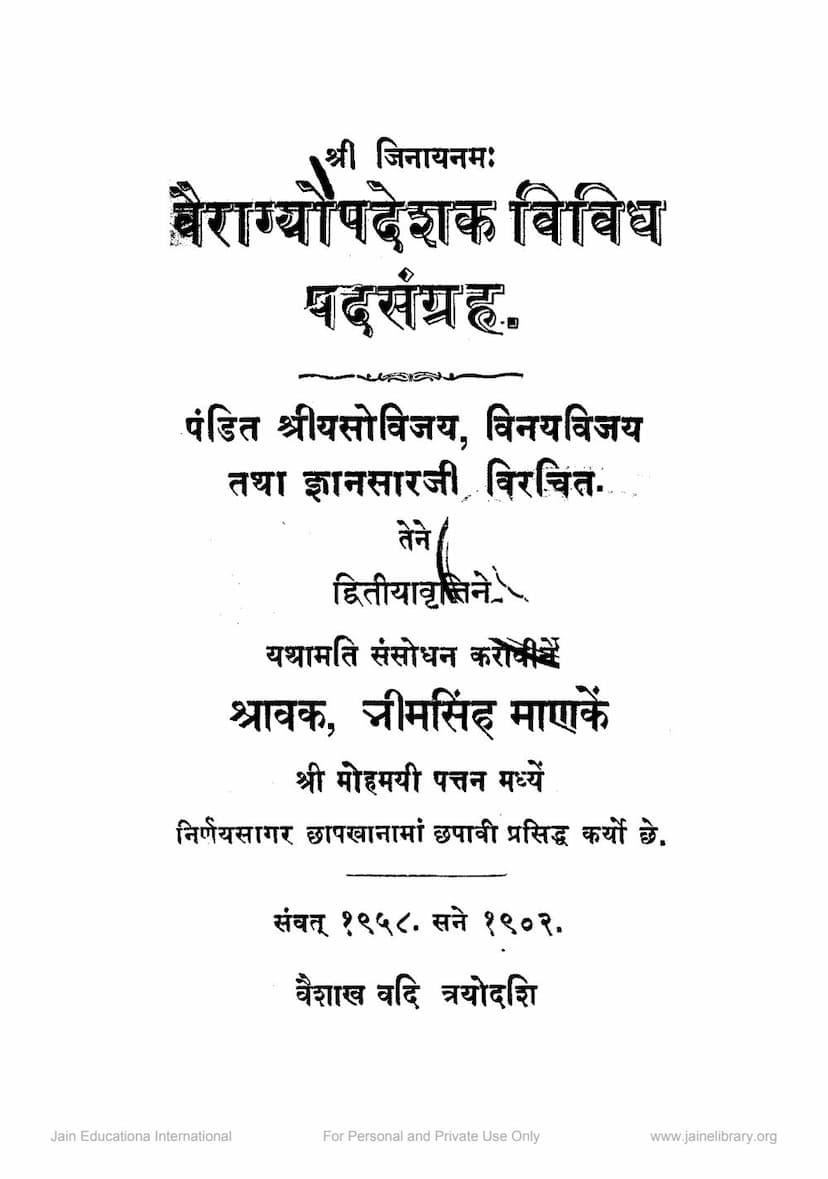Vairagyopadeshak Vividh Pad Sangraha
Added to library: September 2, 2025

Summary
Here is a comprehensive summary of the Jain text "Vairagyopadeshak Vividh Pad Sangraha" based on the provided pages:
Book Title: Vairagyopadeshak Vividh Pad Sangraha Author(s): Shravak Bhimsinh Manek (editor/publisher of the second edition), originally composed by Pandit Shriyasvijayji, Vinay Vijayji, and Gyan Sarji. Publisher: Shravak Bhimsinh Manek Catalog Link: https://jainqq.org/explore/005365/1
Overall Purpose:
"Vairagyopadeshak Vividh Pad Sangraha" is a collection of devotional and philosophical songs or verses (padas) designed to instill detachment (vairagya) from worldly affairs and guide individuals towards spiritual enlightenment. The collection emphasizes the transient nature of worldly pleasures and the importance of spiritual knowledge and practice according to Jain principles.
Structure and Content:
The book is presented as a compilation of works by three renowned Jain scholars:
- Shri Yashvilas: Composed by Pandit Yash Vijayji.
- Shri Vinayvilas: Composed by Pandit Vinay Vijayji.
- Shri Gyanvilas: Composed by Pandit Gyan Sarji.
The introduction (Prastavana) by Shravak Bhimsinh Manek highlights the beauty, detachment-inspiring nature, and poetic brilliance of the collection. He encourages readers to absorb the essence of the verses and offers an apology for any potential errors due to oversight or intellectual limitations. The work was published in Vikram Samvat 1958 (1902 AD).
The collection consists of numerous padas, each set to a specific musical raga, making them suitable for devotional singing. The padas cover a wide range of themes relevant to Jain philosophy and practice, including:
- The Illusion of the Worldly Life: Many padas emphasize that worldly possessions, relationships, and pleasures are temporary and ultimately lead to suffering. They warn against attachment to these ephemeral things.
- The Importance of True Knowledge (Gyan): The verses consistently highlight the power of spiritual knowledge to dispel ignorance (avidya) and attachment (moha). True knowledge is presented as the key to liberation.
- Detachment (Vairagya): The core theme is the cultivation of detachment from worldly desires and experiences. This detachment is not mere renunciation but an understanding of the impermanence of the material world.
- The Nature of the Soul (Atma): The padas often refer to the soul as inherently pure, conscious, and blissful, obscured by karmic impurities and worldly attachments.
- Devotion to the Tirthankaras: There are verses expressing deep devotion and surrender to the Jain Tirthankaras, particularly Lord Rishabhadeva, Lord Neminatha, Lord Parshvanatha, and Lord Mahavira, recognizing them as the ultimate guides and saviors.
- The Role of the Guru: The importance of a spiritual teacher (Guru) is implied and sometimes directly mentioned as essential for understanding the scriptures and attaining liberation.
- Practices for Spiritual Progress: The padas encourage practices like meditation, contemplation, adherence to ethical principles (sheel, samayik), and the renunciation of negative emotions like anger, pride, deceit, and greed.
- The Goal of Liberation (Moksha): The ultimate aim of these teachings is to achieve liberation from the cycle of birth and death and attain eternal bliss.
Key Concepts and Themes Illustrated in the Padas:
The padas systematically explore various aspects of Jain spiritual practice and philosophy. For instance:
- Yashvilas (Pages 5-20): Focuses on differentiating between deluded perception ("Moh Drishti") and true spiritual insight ("Gyan Drishti"), the futility of worldly attachments without a spiritual guide, the true meaning of being a Jain, the nature of the divine, the soul's inherent power, and the cyclical nature of life and death.
- Vinayvilas (Pages 65-89): Emphasizes devotion, the illusion of worldly relationships, the impermanence of life, the importance of controlling the mind, seeking the vision of the Tirthankaras, and the true spiritual path. It highlights the need for spiritual wealth over material wealth.
- Gyanvilas (Pages 91-157): Delves deeper into spiritual knowledge, differentiating between external rituals and internal understanding, the true nature of the soul, the path of the yogi, the illusory nature of worldly achievements, and the importance of self-realization and the path to liberation. The padas stress the necessity of correct knowledge and conduct.
- Sanyam Tarang (Pages 137-157): Focuses on the practice of restraint (sanyam) and the yogic path. It describes the internal journey of controlling the senses, the mind, and the breath through yogic practices, leading to the realization of the soul's true nature and the attainment of bliss.
- Ashtapadi (Pages 157-164): A specific section dedicated to praising Anandghanji, a renowned Jain saint and poet. These verses highlight the blissful nature of Anandghanji's devotion and the transcendental state achieved through his spiritual path.
Significance:
"Vairagyopadeshak Vividh Pad Sangraha" serves as a valuable resource for Jains seeking to deepen their spiritual understanding and practice detachment. Its lyrical and poetic format makes the profound philosophical teachings accessible and engaging, encouraging sincere devotion and a commitment to the Jain path towards ultimate liberation. The collection represents the wisdom and devotional fervor of eminent Jain scholars passed down through generations.